Mastering the Art of Pie Dough Rollers
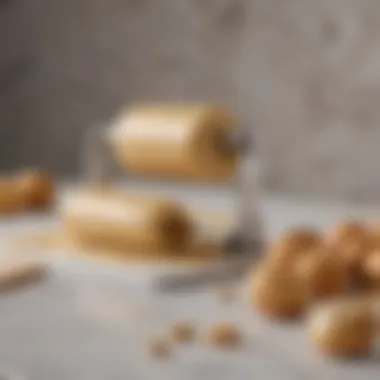
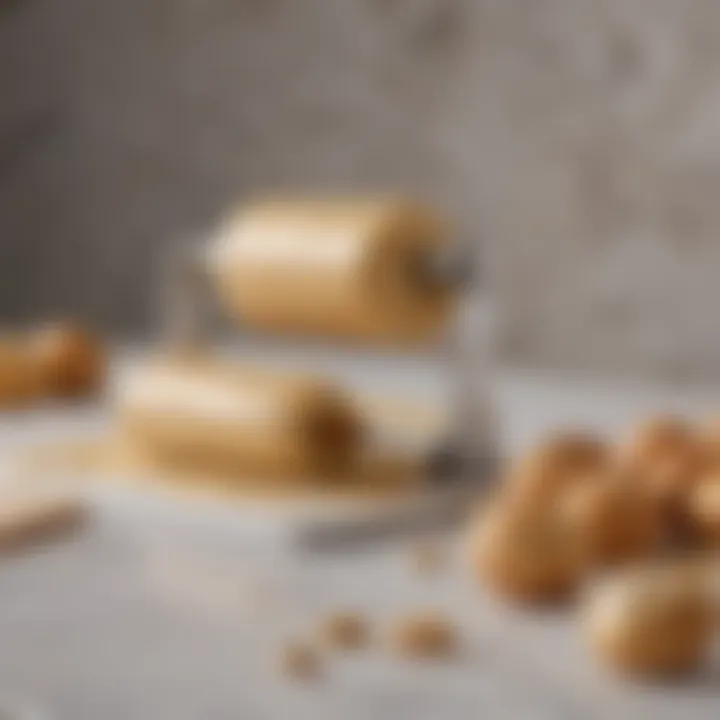
Intro
The ability to create a perfect pie crust is a fundamental skill in baking, demanding both art and precision. One of the essential tools for mastering this skill is the pie dough roller. Using a pie dough roller effectively can elevate home-baked pastries to a professional level. Such a tool simplifies the process, allowing for even and precise rolling of dough. Understanding its nuances can open the door to a variety of pastry creations.
Types of Pie Dough Rollers
There are multiple types of pie dough rollers available, each with specific features that cater to different needs.
- Traditional Wooden Roller: This classic option is often favored for its weight and stability. It provides good pressure for rolling but may require a bit of maintenance.
- Marble Roller: Marble retains cool temperatures, making it ideal for keeping dough from becoming overly warm during rolling, a common issue with buttery doughs.
- Plastic Roller: Lightweight and easy to handle, plastic rollers often come with non-stick surfaces, reducing the need for additional flour.
- Silicone Roller: Flexible and non-stick, silicone rollers are great for rolling out doughs that are sticky. They can also provide various shapes and sizes of rollers to suit different tasks.
Each type serves its purpose; choosing the appropriate roller is the first step to ensuring pastry success.
Recipe Overview
While this article does not focus on a single recipe, mastering the technique of rolling dough will empower bakers to create a multitude of pies, from classic apple to intricate quiches. Flawless crusts enhance the overall dish, improving both texture and flavor.
Ingredients List
For a basic pie crust, the main ingredients typically used include:
- All-purpose flour
- Unsalted butter or shortening
- Ice water
- Salt
Optional ingredients can enhance flavor and texture:
- Sugar (for sweet crust)
- Eggs (to enrich the dough)
- Various spices to complement fillings
By understanding these components, bakers can modify their crust according to personal preferences.
Best Practices for Using a Pie Dough Roller
Achieving a well-rolled dough involves several key practices:
- Chill Ingredients: Cold butter and ice water help achieve a flaky crust.
- Flour Your Surface: Prevents the dough from sticking while rolling it out.
- Even Pressure: Apply consistent pressure to create a uniform thickness.
- Rotate the Dough: Frequently rotating helps avoid uneven rolling.
- Take Breaks: If dough becomes elastic, let it rest for a few minutes before continuing.
Implementing these practices can significantly enhance the quality of pie crusts.
Common Mistakes
Even experienced bakers can overlook details that lead to subpar results. Common pitfalls include:
- Adding too much flour while rolling, resulting in a tough crust.
- Overworking the dough, which can lead to toughness.
- Neglecting to chill the dough, causing it to stick and lose its shape.
Identifying these mistakes helps to refine technique, leading to better outcomes.
Maintenance and Care
Proper maintenance extends the life of pie dough rollers and ensures optimal performance:
- For wooden roller: Wash with warm, soapy water and dry immediately. Avoid soaking.
- For marble roller: Wipe clean with a damp cloth and regularly check for cracks.
- For silicone roller: Hand wash or place in top rack of dishwasher.
By following these maintenance tips, bakers can enjoy their tools for many years.
Understanding the Pie Dough Roller
Using a pie dough roller is more than just a cooking technique; it is an essential tool that transforms how one interacts with pastry. Understanding the intricacies of this tool elevates not only the quality of the pie crust but also enhances the overall baking experience. It aids in achieving uniform thickness, creating more even baking results. Furthermore, knowing the right way to use a pie dough roller can lead to consistent outcomes and prevent common mistakes that may arise from improper technique.
Definition and Purpose
A pie dough roller, also known as a rolling pin, is a cylindrical kitchen tool used to flatten the dough into a sheet. By applying gentle pressure, the roller alters the dough’s shape and thickness, preparing it for filling and baking. The uniform pressure helps ensure that the dough maintains the right texture to create a flaky crust after baking. The simple design of the roller belies its significant impact on the culinary world.
The purpose of the pie dough roller isn’t limited to making pie crusts. It also serves multiple purposes in the broader pastry realm, such as creating tarts, cookies, and pizza dough. With careful handling, the tool can help achieve desired results in various types of pastry preparations.
Historical Background
The history of the pie dough roller is quite fascinating. Its origins trace back several centuries. Early examples date to Ancient Egypt, where wooden rollers were used for flattening dough. As cooking techniques evolved, so did the design and materials used in rolling pins.
In Europe, during the Middle Ages, the rolling pin became a standard kitchen fixture. Various cultures adopted the tool in unique ways, creating different shapes and sizes suited to their culinary practices. By the 18th and 19th centuries, the design had further refined, and materials like marble and stainless steel began to emerge alongside traditional wood.
Today, with advancements in technology, pie dough rollers come in various forms tailored to specific cooking needs. The evolution of this seemingly simple kitchen tool reflects the broader changes in culinary arts and traditions. Understanding this history enables cooks to appreciate the role of the pie dough roller in modern cooking culture.
Types of Pie Dough Rollers
The choice of pie dough roller can significantly influence the outcome of your baking. Understanding the various types allows bakers to select the right tool depending on personal preferences and specific needs. Different materials and designs offer unique benefits that can enhance or hinder dough preparation. This section will cover the most common types of pie dough rollers, detailing the characteristics of each and providing guidance on when to use them.
Traditional Wooden Rollers
Traditional wooden rollers are often the go-to choice for many bakers. They are simple in design, typically made from a solid piece of wood. This type of roller provides a natural, non-stick surface, especially when lightly dusted with flour.
Advantages:
- Durability: Wooden rollers can last for years if maintained well.
- Weight: They tend to have a favorable weight that allows for easy handling while rolling out dough.
- Aesthetic Appeal: There is a classic vibe that wooden tools bring to a kitchen, appealing to many home cooks.
Considerations:
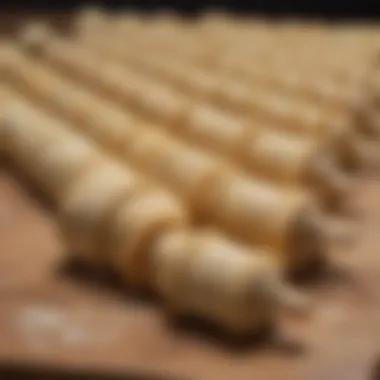
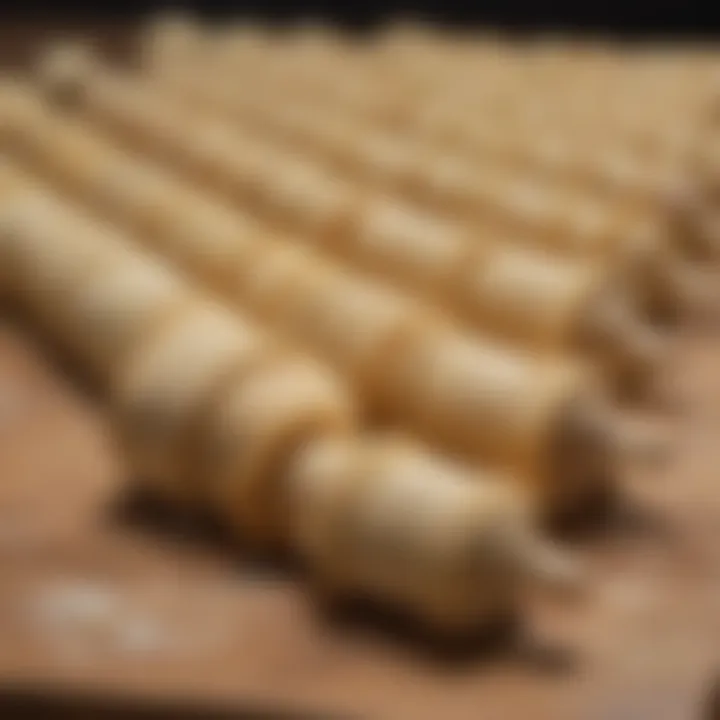
- Requires regular maintenance to keep the wood in good condition.
- There is a learning curve to achieve the right pressure and motion, which can take practice.
Marble Rollers
Marble rollers are elegant and provide some unique benefits. Made of solid marble, these rollers are heavier than wooden ones. The cool surface of the marble helps in keeping the dough from becoming too warm, which is a common issue that can lead to shrinkage or overworking the dough.
Advantages:
- Cool Surface: This helps in handling buttery or delicate doughs.
- Weight: The heaviness allows for effortless rolling with minimal effort from the user.
- Easy to Clean: Marble surfaces can be washed easily and are less prone to absorbing odors or flavors.
Considerations:
- Heavier than most other types, which may be cumbersome for some users.
- More fragile; can chip or crack if dropped.
Silicone Rollers
Silicone rollers are a modern innovation in the kitchenware realm. Their flexible surface allows them to conform slightly to the dough, making them a popular choice for novice bakers or those who struggle with control.
Advantages:
- Non-Stick Properties: Silicone provides excellent non-stick capabilities, reducing the need for additional flour and making cleanup a breeze.
- Lightweight: Easy to maneuver for extended periods without fatigue.
- Variety: Silicone rollers come in various colors and designs, appealing to a younger audience or those who enjoy vibrant kitchen tools.
Considerations:
- Less control than wooden or marble rollers, which may affect results.
- Can wear out faster than other materials, sometimes requiring replacement.
Plastic Rollers
Plastic rollers are the most economical option available. They are lightweight and come in a variety of shapes and sizes, making them a practical choice for many bakers.
Advantages:
- Affordability: Often the least expensive option, making them widely accessible.
- Lightweight and Portable: Easily stored and transported, suitable for baking on-the-go.
- Variety: Comes in many designs, often featuring measurement markings for precise rolling.
Considerations:
- Durability: Typically less long-lasting compared to wood or marble.
- Less weight can mean less control when rolling, especially with thicker doughs.
In sum, each type of pie dough roller has distinct characteristics that cater to different needs and preferences. Knowing these differences allows bakers to make informed choices and optimize their pie-making process.
Choosing the Right Pie Dough Roller
Selecting the proper pie dough roller is essential for achieving the desired consistency and texture in your pastry. The right tool can significantly impact the ease of the rolling process and the final result. There are various elements to consider when making a choice, including material, weight, size, and overall ease of use. Understanding these factors helps anyone, from the novice baker to the seasoned professional, enhance their pie-making skills.
Material Considerations
The material of the pie dough roller affects both functionality and maintenance. Common materials include wood, marble, silicone, and plastic. Each type has its unique properties:
- Wood: Traditional wooden rollers are durable and provide a classic feel. They can easily absorb moisture, which may help in rolling dough. Care must be taken to clean the roller properly to prevent bacteria growth.
- Marble: Marble rollers remain cool, aiding in preventing dough from warming too quickly. This is particularly beneficial for flaky pastries. They are heavier, which can help with adequate pressure during rolling.
- Silicone: These rollers are flexible and non-stick, perfect for those who often face sticking problems. They are also easy to clean and maintain. However, they may lack the heft that some bakers prefer for rolling out denser dough types.
- Plastic: Lightweight and often economical, plastic rollers are suitable for beginner bakers. However, they may not provide the same durability and effectiveness as wooden or marble rollers.
Choosing the right material can enhance your rolling technique and make your baking experience more enjoyable.
Weight and Size
The weight and size of the roller also play critical roles in its usability. A heavier roller allows for better pressure while rolling, which is useful for achieving an even thickness. Conversely, a lighter roller may be easier to handle for some users but could require more effort to get the same results.
- Length: Standard rollers are usually about 18 to 20 inches long. However, smaller or larger options exist to fit different kitchen spaces and culinary needs. If you often bake smaller quantities, a shorter roller may be more manageable.
- Diameter: A thicker diameter can provide better grip and leverage, while thinner rollers may be easier to maneuver. It is advisable to choose a roller that feels comfortable in your hands and aligns with the type of pastry you most frequently prepare.
Ease of Use
The ease of using a pie dough roller can affect the overall baking process. A tool that feels awkward or cumbersome can lead to frustration and poor results.
- Grip: A comfortable grip is vital. Handles should fit your hands well without causing strain. Look for rollers with ergonomic designs for enhanced comfort during use.
- Non-stick Features: Rollers with non-stick surfaces, such as silicone, can reduce the time spent dusting flour, leading to a smoother experience. This feature helps maintain the integrity of the dough during rolling.
- Cleaning and Maintenance: Consider how easy the material is to clean. Non-porous materials like marble and silicone are often easier to maintain than wooden rollers, which can absorb oils and odors.
In summary, choosing the right pie dough roller involves understanding how material, weight, size, and ease of use influence both the baking process and the final outcome. By carefully assessing these factors, you set the stage for successful pie-making.
Techniques for Using a Pie Dough Roller
Using a pie dough roller efficiently is an essential skill for anyone who wishes to create a perfect pie crust. The techniques involved in this process not only influence the texture and flavor of the final product but also enhance the overall pastry-making experience. The right techniques can lead to consistently successful outcomes, allowing cooks to experiment with recipes and ingredients more freely.
Preparing the Dough
Preparation is the foundation of any successful pastry work. For pie crusts, it involves carefully measuring ingredients such as flour, butter, and water. Ensuring that your ingredients are cold helps maintain the desired texture. When mixing the dough, aim for a consistency that is not too dry or too wet.
A basic method is to use a pastry cutter or your fingers to blend flour and butter until it resembles coarse crumbs. Adding cold water gradually is crucial; too much can lead to a tough crust. After mixing, allow the dough to rest in the refrigerator for at least 30 minutes. This resting period relaxes the gluten, making it easier to roll out later.
Keeping the dough chilled prevents it from becoming sticky and allows for a smoother rolling process with the pie dough roller.
Dusting Techniques
Effective dusting is critical to rolling out dough. It reduces friction between the dough and the roller, preventing sticking. Typically, flour is used for this purpose. However, alternatives include using cornstarch or a specialized dough release product. Each option has its benefits, so experimentation may be necessary to find the best fit for your workflow.
A light dusting on both the work surface and the dough is generally sufficient. Excess flour could alter the moisture balance, leading to undesired results. When dusting, consider a fine mesh sieve to achieve an even application. This technique ensures you do not overdo it and can lead to a more polished appearance.

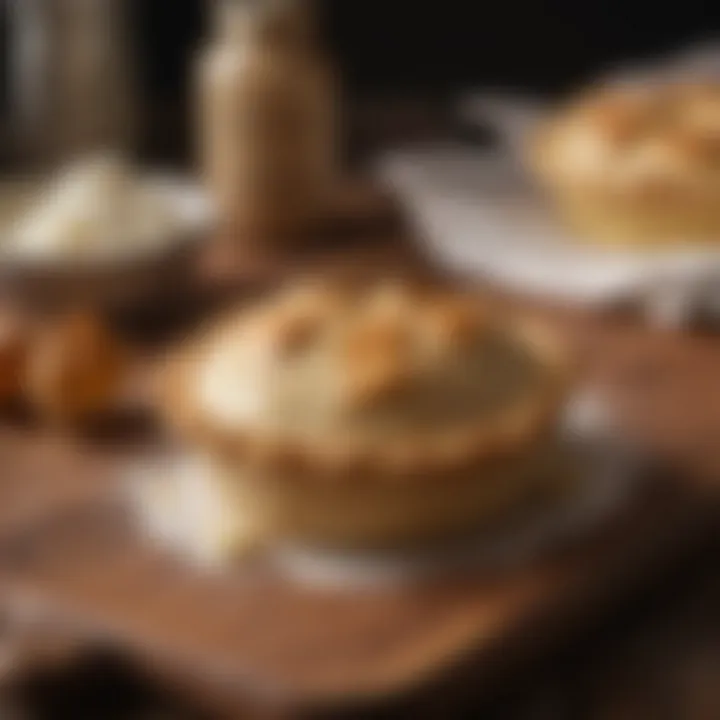
Rolling Methods
From Center to Edge
The method of rolling from the center to the edge is a cornerstone technique when using a pie dough roller. This approach ensures even pressure is applied throughout the dough. Starting at the center allows the sides to stretch evenly, preventing thin edges that could break during handling.
This method is beneficial because it minimizes the risk of uneven thickness, which can have a significant impact on runtime and baking. Additionally, this technique helps maintain a consistent shape, particularly important when crafting circular pastries. However, it requires practice to ensure even application without overworking the dough.
Consistency in Thickness
Maintaining consistency in thickness throughout the dough is also crucial. An even thickness promotes uniform cooking, which helps avoid raw spots or overcooked areas. Experts recommend aiming for approximately one-eighth-inch thickness for most pie crusts.
Using rolling pin rings can assist in achieving this consistency. These rings act as a guide for uniform thickness, assuring a well-prepared crust every time. However, care should be taken to avoid pressing too hard, as this can alter the dough’s integrity and lead to results that are less than ideal.
In summary, mastering the techniques for using a pie dough roller is vital for achieving the perfect crust. Focus on preparation, dusting, and the methods employed during rolling to elevate your pastry skills. With practice, these techniques will become second nature, leading to fantastic results in your culinary endeavors.
Common Mistakes When Using a Pie Dough Roller
When making pie crusts, even a small oversight can lead to undesirable outcomes. Understanding common mistakes associated with using a pie dough roller is essential for achieving that perfect texture and flavor.
Recognizing and avoiding these pitfalls enhances the pie-making process. It can save time, ingredients, and frustration. Let’s explore these common errors to improve your pastry skills.
Overworking the Dough
Overworking dough is a frequent mistake among bakers. When dough is excessively handled, the gluten develops too much. This can result in a tough, chewy crust instead of the desired flakiness. To prevent overworking, limit the number of times you roll out the dough.
Use gentle pressure when rolling. Aim for even thickness without excessive handling. If the dough feels warm or sticky, refrigerate it briefly before continuing. Cold dough is easier to manage and helps maintain the right consistency. Remember, less is more when it comes to handling pie dough.
Inadequate Dusting
Another significant error is inadequate dusting. Flour is critical to prevent sticking during the rolling process. Insufficient dusting can make the dough cling to the roller or the work surface, leading to tears and uneven shapes.
Before you roll out your dough, sprinkle a generous amount of flour on the surface and the roller itself. Reapply flour as necessary, especially if you notice any sticking. Ensure you distribute the flour evenly to maintain an adequate barrier between the dough and the surfaces. This simple step can save your dough from major complications.
Rolling Too Thin
Rolling the dough too thin is a further mistake that often leads to unsatisfactory results. When the dough is excessively thin, it can break apart, and it may not hold fillings effectively. A thin crust can also dry out during baking, resulting in an undesirable texture.
Aim for an even thickness of about one-eighth to a quarter of an inch. This ensures the crust can support fillings and retain moisture. Moreover, if using a lattice or decorative top pie crust, maintain a similar thickness to ensure uniform baking.
"The right thickness allows for even cooking, which is crucial for achieving the desired result."
To wrap up, avoiding these common mistakes will drastically improve your pie crust outcomes. Being mindful of dough handling, proper dusting, and achieving the right thickness will ultimately lead to delicious results in your baking journey.
Maintaining Your Pie Dough Roller
Maintaining a pie dough roller is essential for ensuring its longevity and consistent performance. Proper care not only enhances the effectiveness of the roller but also protects investment in high-quality tools. Over time, neglect can lead to damage or reduced functionality, resulting in poorer pie crusts. By focusing on thorough cleaning and appropriate storage, bakers can uphold the integrity of their rollers and enjoy better results.
Cleaning Techniques
Cleaning your pie dough roller is one critical aspect of maintenance to keep it in optimal condition. Depending on the materials used in the roller's construction, the cleaning methods may vary. For wooden rollers, it is important to avoid soaking them in water as this can cause warping. Instead, one should use a damp cloth to wipe off excess dough and flour. A gentle scrub with a soft brush can help remove any stubborn residues without damaging the wood.
For silicone or marble rollers, cleaning is straightforward. They can be washed with warm, soapy water or placed in the dishwasher, if applicable. It is wise to ensure they are completely dry before storing, as moisture can encourage mold growth.
Here are some practices to follow for effective cleaning:
- Wipe after each use: Removing flour and dough prevents buildup.
- Use gentle cleaners: Harsh chemicals can ruin the surface of the roller.
- Inspect for scratches: Ensure the surface is smooth for rolling perfection.
"Regular maintenance allows for a seamless baking experience and ensures the best outcome in pastry preparations."
Storage Solutions
Storage of pie dough rollers can also impact their functionality. Proper storage prevents potential damage and ensures they remain in excellent condition. Ideally, rollers should be stored in a dry area away from direct sunlight. It is best to position them horizontally to avoid any strain on the material. For wooden rollers, a sleeve made from cotton fabric can protect from dust and scratches.
If space is limited, consider placing the roller in a designated drawer or container that provides sufficient cushioning, such as a soft cloth. Avoid stacking heavy items on top of the roller, as this can lead to warping or denting.
Essential tips for storage include:
- Designate a specific spot: Keeping it in the same place helps avoid misplacement.
- Use protective coverings: Prevent damage during storage with cloth or sleeves.
- Avoid extreme temperatures: Protect rollers from hot or humid environments that may affect materials.
By integrating these cleaning and storage practices into your routine, the pie dough roller will serve for many baking sessions to come, ensuring you achieve the desired outcomes in all your pie creations.
Alternatives to Using a Pie Dough Roller
While a pie dough roller is a favored tool among bakers, there are various alternatives that can produce excellent results. Recognizing these options is significant, as they can cater to different preferences, skill levels, and circumstances. These alternatives provide unique benefits that might appeal to specific users, such as those with limited space, budget concerns, or different baking styles. Moreover, understanding these methods can enhance a cook's overall repertoire within the culinary world.
Using Your Hands
Rolling pie dough by hand is, perhaps, the most instinctive alternative to a pie dough roller. This method allows direct interaction with the dough, connecting the baker with the material. It involves flattening the dough using the palms and fingertips, which may seem less refined but can be effective.
- Benefits:
- More tactile control over the thickness of the dough.
- Suitable for smaller kitchens without specialized equipment.
- Helps prevent overworking the dough compared to using mechanical tools.
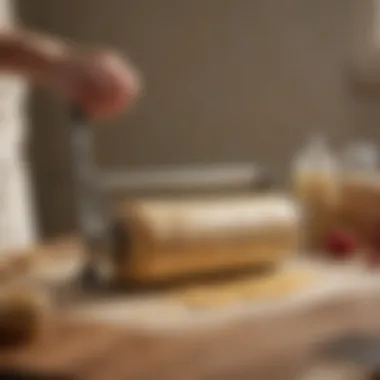
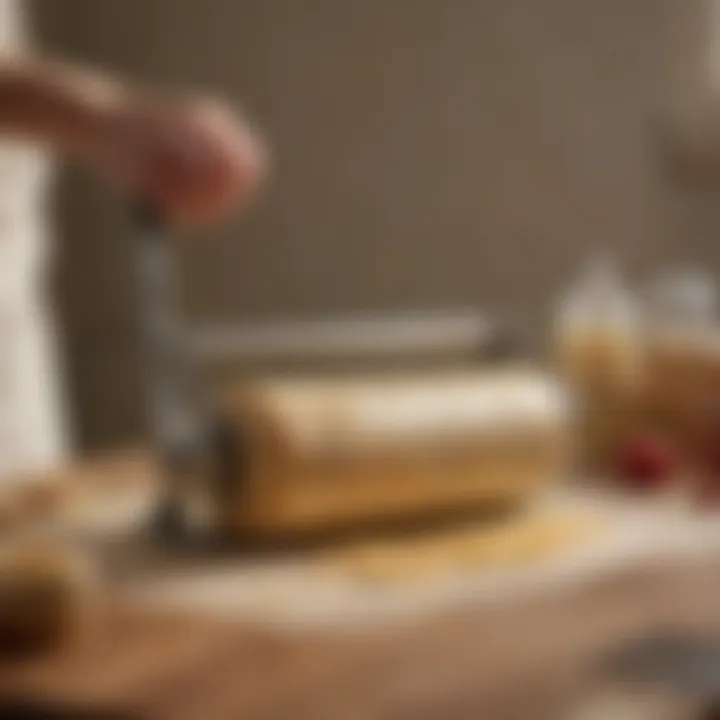
Using hands is particularly advantageous when one desires a more rustic pie crust. The warmth from your hands can make the dough pliable without the unintentional pressure that a rolling pin might apply. However, it requires a certain level of practice to achieve even thickness without intentionally overworking the dough.
Using a Food Processor
The food processor serves as a popular alternative for those seeking efficiency and precision in their pie dough preparation. By combining flour and other ingredients quickly, the food processor can save time and ensure consistent mixing.
- Key Advantages:
- Rapidly combines ingredients for even results.
- Ideal for making dough in larger batches with less physical effort.
- Useful for incorporating fats consistently within the mixture.
Once the dough is mixed, it can be easily formed into a disc for chilling before rolling. It's crucial to avoid over-processing, as this can lead to tough dough. The food processor can also accommodate various types of dough, adapting seamlessly to the cook's needs.
Pre-made Dough Options
For those who prioritize convenience or lack the time to make dough from scratch, pre-made dough options are a viable solution. Many grocery stores now offer a variety of ready-to-use dough, which provides a shortcut to pie-making without sacrificing quality.
- Considerations:
- Immediate availability for time-pressed bakers.
- Consistency in flavor and texture, depending on brand choice.
- Useful for beginners who are not yet comfortable with dough-making techniques.
Pre-made dough options come in various forms, from traditional pie crusts to whole wheat, or even gluten-free options. However, cooks should read the labels carefully, as some commercial dough can contain preservatives or artificial ingredients.
"Exploring alternatives to traditional tools opens up a wider range of creative options in pie baking. Each method has its unique strengths and can be tailored to suit individual needs."
In summary, while a pie dough roller can be an exceptional asset for precise pastry work, using hands, food processors, or pre-made dough brings flexibility and accessibility to the pie-making process. These alternatives encourage experimentation and can cater to both beginners and experienced bakers looking to expand their culinary skills.
Culinary Applications Beyond Pies
The versatility of a pie dough roller extends far beyond its conventional use in pie preparation. Understanding its broader culinary applications can significantly enhance one’s pastry skills. Tarts, galettes, and quiches represent a few of the delightful offerings that benefit from the use of a pie dough roller, each bringing unique textures and flavors to the table. By optimizing the use of this tool in diverse applications, cooks can achieve professional-quality results effortlessly.
Tarts and Galettes
Tarts and galettes showcase the pie dough roller's ability to create an even, thin crust that serves as the foundation for various fillings. Tarts, typically baked in a fluted tart pan, require precision in the dough's thickness. When using a pie dough roller, ensure the dough is rolled evenly, as this will prevent shrinkage during baking and promote a consistent texture.
- Crust Variations: Different types of crusts, such as sweet or savory, can be employed in tarts and galettes. A simple change in the flavoring, like incorporating almond extract or herbs, can elevate a traditional tart into an exciting culinary experience.
- Filling Choices: Both tarts and galettes allow for creativity with fillings ranging from fruits to custards or even meat mixtures. The ability to roll dough uniformly leads to a balanced cook on the crust, enhancing the overall flavor profile of the dish.
In making galettes, the rustic approach allows for flexibility while still benefiting from the evenness that a pie dough roller can provide. They can be folded over to encase the fillings, again demonstrating the roller's importance in achieving a desirable thinness, allowing the ingredients to shine.
Quiches
Quiches are another culinary application that illustrates the pie dough roller's importance. A quiche relies on a beautifully crafted shell to cradle a savory custard, and achieving the right thickness is crucial for texture and structure.
- Shell Integrity: The even rolling of the dough ensures that the shell maintains its structure during baking. Any weak spots could lead to cracks or leaks, compromising the quiche’s integrity.
- Flavor Infusion: The choice of crust also influences the overall flavor. Using a flavored crust, such as incorporating cheese or spices into the dough, adds lines of flavor that complement the fillings, which can range from vegetables to meats and cheeses.
The application of a pie dough roller in the context of tarts, galettes, and quiches not only streamlines the dough preparation process but also results in a polished end product. As a cook becomes familiar with these various uses, they discover that the skillful application of this simple tool can open up a whole new world of culinary possibilities.
"A well-rolled pie crust can transform a dish, making it not only look professional but also enhancing the flavor and texture in remarkable ways."
In summary, the pie dough roller is not merely a tool for making pie crusts; it is an essential instrument in the culinary arsenal, particularly for creating a variety of pastry-based dishes. The benefits of consistent thickness, improved handling, and diverse applications far outweigh the effort invested in mastering its techniques.
The Impact of Pie Dough Rollers on Culinary Trends
The pie dough roller is not just a basic kitchen tool; it has a significant influence on culinary trends. This impact can be seen in various ways, including the resurgence of home baking, the artisanal approach, and a growing trend towards healthy ingredients. Pie dough rollers, in their diverse forms, have revived interests in pastry preparation, empowering both amateur and professional bakers alike.
Artisan Baking Movement
The artisan baking movement emphasizes craft and quality. In this era, kitchen tools like the pie dough roller have become invaluable. These rollers enable bakers to have a more hands-on approach. Using a high-quality wooden roller, for example, connects the baker to tradition, making the act of rolling dough an experience rather than a task. The increased focus on artisanal methods has led to a renaissance in pie-making fairs, workshops, and local baking contests.
The presence of pie dough rollers in bakeries supports a shift from mass-produced to hand-crafted goods. Bakeries often use these rollers to achieve a consistent thickness while maintaining the unique characteristics of each pie crust. This speaks to consumers’ desires for authenticity in food. When they see pies made with skilled techniques, their appreciation for labor-intensive processes grows. Moreover, this trend encourages them to replicate such processes at home, enhancing their baking journey.
Health-Conscious Baking
In recent years, health-conscious baking has gained much attention. More people are opting to make their baked goods rather than buying industrial products. Pie dough rollers play a role here as well. They allow for direct control over ingredients. With a roller, bakers can choose whole grains or alternative flours, resulting in healthier, homemade pie crusts.
Furthermore, the meticulous process of rolling dough can motivate individuals to be mindful of what they consume. By using organic or natural ingredients, bakers can create delicious pies without unnecessary additives. This aligns well with the growing trend of transparency about food sources.
"The art of rolling dough is not just about technique; it's also about enhancing ingredient quality, leading to a greater awareness of food choices."
In summary, pie dough rollers are central to broader shifts in the culinary landscape. They embody a blend of tradition, craftsmanship, and healthy practices, providing a bridge between past and present. This confluence enriches the culinary fabric of modern society, making the act of baking a rewarding pursuit.
Closure
In the realm of pastry arts, the role of the pie dough roller is crucial. This article has established the significance of mastering this tool, which extends beyond mere convenience. Understanding how to utilize a pie dough roller effectively can greatly influence the quality of your pie crusts. From choosing the right material to adopting proper techniques, each step contributes to achieving a desirable texture and flavor in pastries.
Recap of Critical Insights
Throughout this article, several key points have been emphasized:
- Types of Rollers: Recognizing the differences between traditional wooden rollers, marble, silicone, and plastic rollers helps in selecting the best option for your baking style.
- Techniques: The importance of preparing the dough and employing effective dusting methods cannot be overstated. These techniques are fundamental for ensuring a smooth rolling process and preventing sticking.
- Common Mistakes: Awareness of common pitfalls, such as overworking the dough or rolling it too thin, aids in avoiding common frustrations encountered by bakers.
- Maintenance: Cleaning and storage practices for your pie dough roller are vital for prolonging its life and maintaining hygiene.
These insights form a basis for a proficient approach as you engage with pastry preparation.
Encouragement for Experimentation
As you delve deeper into the art of pastry, it is beneficial to embrace experimentation. Try various types of doughs, roll with different thicknesses, and explore new flavors.
Using your hands instead of a roller, or incorporating alternative methods like food processors, can lead to surprising results. Each attempt not only hones your skills but also expands your culinary horizon.
Every baker has a unique style, and finding your voice through experimentation enhances creativity and enjoyment in the kitchen. Whether you’re a novice or experienced cook, pushing boundaries can yield delightful and unexpected outcomes.
"Baking is both an art and a science; understanding one enhances the other."







